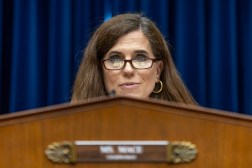IT modernization bill needs continued push from industry, Rep. Hurd says

With about two weeks before the current Congress closes out for good, many in the federal tech community are wondering how to spur movement in the Senate around the Modernizing Government Technology Act.
To Rep. Will Hurd, R-Texas, an author of the House-passed version of the bill, it’s simple. Or perhaps it’s that the options are growing slim.
“Call them,” said Hurd, the chairman of the IT Subcommittee of House Committee on Oversight and Government Reform. He was re-elected to his seat in November and will retain the chairmanship next year.
Hurd wants those industry leaders and anyone concerned with the outcome of his bill and federal IT modernization to talk to their senators and the members of the Senate Committee on Homeland Security and Governmental Affairs about it.
“For those that already have, thank you. It’s a big deal. The fact that industry shows that this is important and wants to see this happen, that has an impact,” he said Wednesday at a data center optimization event hosted by Schneider Electric. “Talking to those members is important. And I do think we still have a window to pull this off.”
But that window, which ends Dec. 16 when Congress is expected to wrap up work for the year, is becoming alarmingly small.
“The clock is running out,” Hurd said — but he hasn’t completely given up hope. Borrowing a metaphor, “I’ve attached the flag to the pole,” he said. “I’m not raising a red flag, but it’s attached.”
An IT reform bill such as this one, Hurd said, is fairly bipartisan. It would create individual IT working capital funds for each of the 24 CFO Act agencies and a centralized IT modernization fund housed in the Treasury Department that executive branch agencies could apply to draw from and repay in a given time.
If the speed at which the House was able to pass the bill any indication, the Senate could very well pull it off, Hurd said.
“Honestly, it’s a big deal that we were able to pass this [under suspension of the the rules] out of the House,” he said. “That shows the level of work that was done in advance and the cooperation.”
While the bill as it stands doesn’t account for any sort of funding, it does build a model in which agencies can plan in longer cycles for modernization and how to reinvest any savings they incur, moving them away from “the notion of if you don’t use it you lose it,” Hurd said.
Federal systems and networks are “so big that in order to change within a calendar, it is incredibly difficult,” he said. “If you realize savings, it is incredibly difficult to utilize that savings within the same calendar year. So why not put in a working capital fund for three years so you have access to it?”
U.S. CIO Tony Scott is a major proponent of the bill and agencies’ ability to not only modernize in the short term but also to continue to do so in regular cycles. Any savings or money paid back to the central fund “can be used to fund the next set of initiatives, which is important as well,” he said.
Scott, who also spoke at the data center event Wednesday, described how this sort of modernization — if managed right and done well — can make it so agencies can “reinvest in a way that you don’t ever have to ask for a budget increase.”
“In my experience, if you get on this flywheel of continuous upgrade and continuous reinvestment, it actually costs you less, and you’re more efficient, more effective and more responsive to your customers needs,” he said. “And this is true across infrastructure, applications, the whole space. That’s why we’ve got to get on this. That’s why it’s urgent.”




